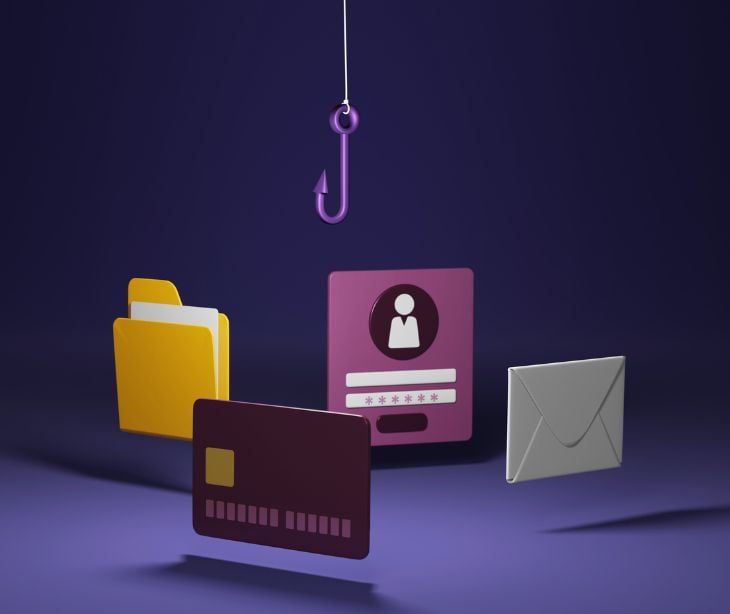
Phishing attacks are fraudulent emails, text messages, phone calls, or websites designed to trick users into downloading malware, sharing sensitive information, or taking other actions that expose themselves or their organizations to cybercrime.
Understanding phishing attacks
Phishing aims to trick users into providing personal data such as Social Security numbers, credit card information, login credentials, or downloading malware onto their devices.
The impact of phishing attacks can be severe, leading to identity theft, credit card fraud, ransomware attacks, data breaches, and significant financial losses for both individuals and organizations. These attacks exploit human error and rely on social engineering tactics to manipulate individuals into divulging information or taking actions that benefit cyber criminals.
Related: What is an email phishing attack?
Types of phishing attacks
Phishing attacks come in various forms, each with its tactics and targets. Understanding the different types of phishing attacks can help individuals and organizations recognize and protect themselves against these threats.
Bulk phishing emails
Bulk email phishing is the most common phishing attack, where scammers send mass emails impersonating well-known businesses or organizations. These emails often include the logo of the impersonated sender and employ techniques to appear legitimate; however, the email contains instructions that prompt individuals to divulge sensitive information or download malicious files.
Spear phishing
Spear phishing attacks are more targeted and personalized compared to bulk phishing emails. Scammers research their victims to gather information that allows them to pose as someone the target trusts, such as a colleague, boss, or trusted vendor. Social media platforms provide rich sources of information for spear phishing research. The attackers use this information to send messages containing specific personal or financial details, often with urgent requests.
Business email compromise (BEC)
BEC attacks focus on stealing large sums of money or valuable information from corporations or institutions. Two common forms of BEC attacks include CEO fraud and Email Account Compromise (EAC). CEO fraud involves impersonating a high-level executive's email account to instruct lower-level employees to transfer funds or send sensitive information. EAC, on the other hand, involves gaining access to a lower-level employee's email account to send fraudulent invoices or requests for payment.
SMS phishing (Smishing)
Smishing refers to phishing attacks conducted through mobile or smartphone text messages. Scammers send contextual messages about smartphone account management or apps, enticing recipients to share sensitive information or update their payment details.
Voice phishing (Vishing)
Vishing involves phishing attacks conducted via phone calls. Scammers utilize voice-over IP (VoIP) technology to make automated calls in large volumes, often using caller ID spoofing to appear legitimate. These calls typically exploit fear, claiming credit card processing problems, overdue payments, or trouble with the IRS. Victims who respond to these calls end up divulging sensitive data or granting remote control of their computers to the scammers.
Social media phishing
Scammers leverage social media platforms to phish for sensitive information. They use the messaging capabilities of platforms like Facebook Messenger, LinkedIn, or Twitter to send phishing messages. They may also send phishing emails that appear to come from social networking sites, requesting recipients to update login credentials or payment information.
Recognizing phishing
Phishing emails often include requests for sensitive or personal information, such as payment or profile details. They may also ask recipients to send or move money, open file attachments they did not expect, or create a sense of urgency through threats or time pressure. Poor spelling or grammar, inconsistent sender addresses, shortened links, and images of text are common red flags in phishing emails.
Read also: How to spot AI phishing attempts and other security threats
Best practices
To protect against phishing attacks, individuals and organizations should adopt best practices when dealing with suspicious emails and messages. By following these practices, users can minimize the risk of falling victim to phishing scams.
Avoid sharing information
Be wary about providing personal or financial information in response to emails or messages, especially if they appear suspicious.
Verify requests for personal information
Instead of clicking on links provided in emails or messages, independently verify the request by contacting the sender or visiting their official website through trusted means.
Report phishing
Promptly report any phishing attempts or suspicious emails to your organization's appropriate IT or security group. This helps raise awareness and protects others from potential threats.
Security technologies
Security technologies can provide an extra layer of defense by detecting and preventing phishing attempts.
Email security software
These tools use machine learning algorithms and threat intelligence to identify and divert suspected phishing emails and other forms of spam to a separate folder. They also disable any potentially malicious links contained within these emails.
Antivirus software
These solutions scan incoming emails and attachments for malicious files or code, neutralizing potential threats before they can cause harm.
Multi-factor authentication
By requiring additional credentials beyond usernames and passwords, multi-factor authentication adds an extra layer of security. This can undermine spear phishing attacks and prevent unauthorized access to accounts.
Web filters
Employing web filters can prevent users from accessing known malicious websites or display alerts when visiting suspected fake or malicious sites.
See also: HIPAA Compliant Email: The Definitive Guide
In the news
The use of a new phishing-as-a-service (PhaaS) platform called 'Tycoon 2FA' is gaining popularity among cybercriminals targeting Microsoft 365 and Gmail accounts in an attempt to bypass two-factor authentication (2FA) protection. Discovered by Sekoia analysts during routine threat hunting in October 2023, the PhaaS kit has been active since at least August of that year, when it was offered through private Telegram channels by the Saad Tycoon group.
A newer version of Tycoon, released in 2024, is said to be more covert than its predecessor, indicating ongoing efforts toward improvement. This service currently uses over a thousand domains and has already been used over a thousand times for phishing attacks.
The discovery of the Tycoon 2FA phishing kit is another advance for cybercriminals. Using 2FA is widely accepted as an added layer of security, giving organizations confidence that their systems are protected from cyber threats. Cybercriminals are constantly advancing in their techniques for evading cybersecurity measures organizations implement to safeguard their data. The increasing popularity of the Tycoon 2FA phishing kit could mean 2FA is a false sense of security that is less effective than other safeguarding methods, leading organizations to rethink their security strategies.
Read more: Phishing kit that bypasses MFA targets Gmail and Microsoft 365
FAQs
What should I do if I suspect a phishing attempt?
Refrain from clicking on any links or providing personal information. Instead, the suspicious activity should be reported to the legitimate organization being impersonated.
How can I protect myself from phishing attacks?
Be cautious of unsolicited communications, verify the legitimacy of requests for personal information, and use security software to help identify potential threats.
What are some common examples of phishing attacks?
Examples include emails claiming to be from a bank requesting account details, fake websites mimicking legitimate login pages, and messages impersonating trusted companies requesting sensitive information.
What are the potential consequences of falling victim to a phishing attack?
Victims may experience identity theft, financial loss, unauthorized access to personal accounts, and compromised sensitive data.
Can businesses be targeted by phishing attacks?
Yes, businesses are often targeted through email scams to obtain sensitive company information or gain unauthorized access to corporate networks.
Subscribe to Paubox Weekly
Every Friday we'll bring you the most important news from Paubox. Our aim is to make you smarter, faster.




